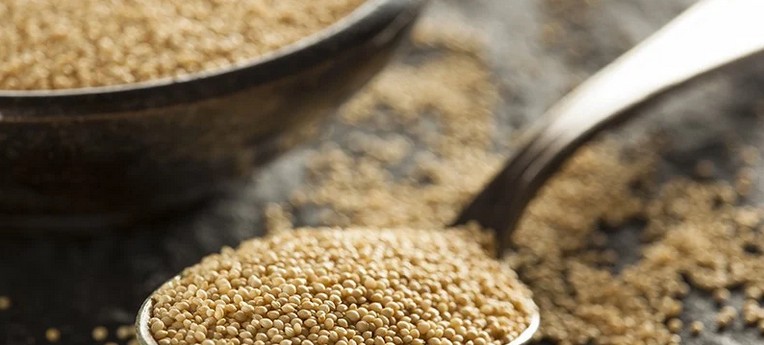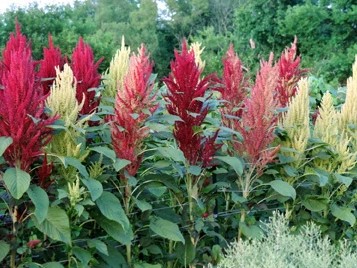😋 Eating Well from the Field of Master Mind Herbs (MMHRB) 🌾
Shared from the research of: Joseph Mercado 😎
Article Author: Christine Ruggeri 👩
Content Contributor: Dr. Axe 👴
Blog Post #1160 📌
Re: The Benefits of Amaranth 🌾
Date and Time: Monday, March 29, 2021 at 1:50 p.m. ⏰
Dear Herbal Lover,
If you’re on the lookout for gluten-free grains that pack a nutritional punch, you’ll definitely want to try amaranth.
The grain is gaining popularity today because of its startling health benefits.
It has an earthy and nutty flavor, helps you to feel full because of its fiber content, and like quinoa, serves as an excellent source of protein.
A 2017 review published in Molecular Nutrition and Food Research indicates that the proteins found in amaranth are particularly high in nutritional quality due to the outstanding balance of essential amino acids.
Plus, the phytochemicals found in amaranth contribute to its antioxidant and anti-inflammatory effects and allows for the grain’s range of health benefits.
If you’re looking for a new gluten-free grain to add to your favorite recipes, give amaranth a try.
It’s tasty, filling and nutritious.
What Is Amaranth?
Amaranth is the common name for more than 60 different species of amaranthus.
This gluten-free grain was a major food crop of the Aztecs, and some estimate that it was domesticated between 6,000 and 8,000 years ago.
Because of the high proteins, minerals and vitamins present in amaranth seeds, these ancient cultures depended on the grain as a major staple in their diets.
Amaranth is still the native crop in Peru, and it’s grown in Africa, India, China, Russia, South America and North America.
It’s a very tall plant with broad green leaves and vividly bright purple, red or gold flowers.
Amaranth grows in harsh and lackluster nutrient conditions, such as in light soils, much like the grain sorghum, so it’s a very efficient grain crop.
“Pigweed” is the wild amaranth species that grows in the United States and is used as a food crop.
Did you know that there are many amaranth products on the market?
The ancient grain can be consumed as a leaf, cereal grain, amaranth flour and amaranth oil.
In fact, the amaranth leaf is used to make medicine, while the grain is used in food for its fiber and protein content, and the oil is applied topically to promote skin health.
The benefits of amaranth come from the fact that it’s a complete protein that has anti-inflammatory and antioxidant effects.
It’s also rich in fiber and has shown to fight heart disease and digestive problems. For these reasons, choosing to cook amaranth and add it to your daily diet can have great benefits.
Nutrition Facts:
Amaranth is a great source of protein, fiber, manganese, magnesium, phosphorus and iron.
It helps keep your digestive system regulated, build your strength, and reduce the risk of fracture or broken bones.
According to the USDA, one cup (approximately 246 grams) of cooked amaranth grain has about:
- 251 calories
- 46 grams carbohydrates
- 9.3 grams protein
- 3.9 grams fat
- 5.2 grams fiber
- 2.1 milligrams manganese (105 percent DV)
- 160 milligrams magnesium (40 percent DV)
- 364 milligrams phosphorus (36 percent DV)
- 5.2 milligrams iron (29 percent DV)
- 13.5 micrograms selenium (19 percent DV)
- 0.4 milligram copper (18 percent DV)
- 0.3 milligram vitamin B6 (14 percent DV)
- 54.1 micrograms folate (14 percent DV)
- 2.1 milligrams zinc (14 percent DV)
- 116 milligrams calcium (12 percent DV)
- 332 milligrams potassium (9 percent DV)
Top 9 Benefits of Amaranth:
1. High Source of Protein:
The protein contained in amaranth is of an unusually high quality, providing nine grams for one cup of cooked grain.
Protein is used in every cell in our bodies and is critical for building muscle mass, supporting neurological function, aiding in digestion, helping balance hormones naturally and keeping an upbeat mood.
Protein foods are also beneficial for preventing weight gain since they make us feel full and require more work for the body to digest than fast-acting refined carbohydrates.
A 2008 study published in the Journal of Sports Medicine and Physical Fitness found that consuming protein before and after exercise has beneficial effects by decreasing exercise-induced muscle damage and promoting muscle-protein synthesis.
This study suggests that protein is useful for muscle recovery and immune regulation for sports events.
2. Reduces Inflammation:
Amaranth has the power to reduce inflammation, which is associated with just about every health condition.
When dietary and environmental toxins build up in the body, the immune system becomes overactive, and it stimulates defense cells and hormones that damage tissues.
When the immune system overreaches and begins attacking healthy body tissues, we’re met with an autoimmune disorder like leaky gut syndrome and inflammation in otherwise healthy areas of the body.
This is also the case for arthritis and fibromyalgia symptoms, as well as celiac and irritable bowel disease.
Because grains and protein-rich foods help fight inflammation, amaranth is a great tool for your body.
A major health benefit of anti-inflammatory foods is the way they relieve pain induced by arthritis and gout.
Arthritis is a joint disease that causes swelling and pain in the joints. One type of arthritis is osteoarthritis, which occurs when the cartilage between joints wears down and causes inflammation and pain. This type of arthritis generally occurs in the joints we most frequently use, such as knees, hips, spine and hands.
A 2014 study published in Molecular Nutrition and Food Research showed that amaranth inhibited inflammation in humans and mice.
This suggests that amaranth serves as a natural treatment for arthritis and has the power to reduce the symptoms of osteoarthritis and other inflammatory conditions.
3. Supports Bone Health:
The calcium present in amaranth grain allows the body to use this mineral for bone repair and strengthening. Including calcium-rich foods in your daily diet is so important because it helps heal broken or weak bones.
A calcium deficiency increases your risk of a fracture and developing osteoporosis, which is when small holes or weakened areas are formed in the bone that can lead to fractures, pain and a Dowager’s hump.
A 2013 study published in the International Journal of Food Sciences and Nutrition found that amaranth consumption is an interesting and effective way to increase the nutritional value of calcium, as well as iron and zinc.
Calcium is so important because without enough of it in the body, bones are susceptible to becoming weak and pliable, making them more prone to fractures and breaks.
Calcium aids in bone strength as the bones build up calcium stores over time.
4. Helps Lower Cholesterol:
A 2003 study published in the International Journal for Vitamin and Nutrition Research tested the effects of amaranth grain on cholesterol levels in animals models.
Amaranth grain decreased very low-density LDL cholesterol by 21 percent to 50 percent. LDL is known as the bad cholesterol because it’s low in proteins and high in cholesterol. Thus, this grain is a cholesterol-lowering food.
Amaranth also aided digestion by increasing fecal excretion or frequency of bowel movements.
This is due to the fiber content present in amaranth.
The fiber binds cholesterol in the digestive system and causes it to be excreted by the body.
Eating high-fiber foods helps the body lower cholesterol naturally. The fiber acts on the bile that’s made from cholesterol, pulling it out of the body with stool.
Because of this process, the liver is required to make more bile, which uses the body’s cholesterol stores, lowering cholesterol overall.
5. Aids Digestive System:
Because of amaranth’s high fiber content, it stimulates the digestive system and helps regulate the excretion of bodily waste.
Due to its structure and our inability to absorb it, fiber passes through the digestive system unabsorbed by digestive enzymes within the stomach, taking with it toxins, waste, fat and cholesterol particles out of the gut.
According to research conducted at Purdue University, 78 percent of the fiber in amaranth is insoluble fiber and 22 percent is soluble fiber, which is a higher proportion than what is found in wheat and maize.
Soluble fiber is vital for proper digestion because it dissolves into a gluey mass and traps fats, sugars, bacteria and toxins.
While aiding the digestive system, amaranth is also able to prevent other health conditions like leaky gut syndrome.
In order to understand leaky gut syndrome, think of the lining of your digestive tract like a net with extremely small holes in it that only allow specific substances to pass through.
Your gut lining works as a barrier — keeping out bigger particles that can damage your system.
This leads to inflammation throughout the digestive system, and it causes fatigue, bloating, weight gain, headaches, skin issues and thyroid problems.
It can also lead to multiple food sensitivities. This is because partially digested protein and fat can seep through your intestinal linking, making their way into the bloodstream and causing an allergic reaction.
By sprouting a grain like amaranth, you get a great source of fiber that can help support the growth of beneficial bacteria, thereby working to treat leaky gut syndrome.
6. Helps Fight Diabetes:
With just a cup of amaranth providing over 100 percent the daily recommended dose of manganese, it can be eaten as part of a diabetic diet that helps reduce high blood sugar levels.
Manganese is needed to help with proper production of digestive enzymes responsible for a process called gluconeogenesis.
Gluconeogenesis involves the conversion of protein’s amino acids into sugar and the balance of sugar within the bloodstream.
According to research published in BMC Endocrine Disorders, the prevalence of diabetes and renal dysfunction increased with participants with low blood manganese levels.
Researchers suggest that low blood manganese may play a role in glucose homeostasis and renal function.
7. It’s Gluten-Free:
Amaranth is gluten-free, so people with sensitivities or intolerances to gluten are free to eat this beneficial grain.
Gluten sensitivity is a cluster of symptoms related to a reaction to the protein found in the wheat plant called gluten.
The severe form of gluten sensitivity is celiac’s disease, but research suggests that non-celiac gluten sensitivity can also cause less severe symptoms, such as joint pain, headaches, fatigue and poor memory.
Symptoms of gluten intolerance may include fatigue, bone and joint pain, arthritis, infertility, miscarriage, depression, and skin rashes, just to name a few.
A gluten-sensitivity diet includes grains like amaranth, quinoa and nutritious buckwheat.
8. Helps Pregnant Women:
The folate in amaranth grain helps the body make new cells, specifically by playing a role in copying and synthesizing DNA.
For pregnant women, a folate deficiency can lead to neural tube defects, such as spina bifida.
A deficiency can also cause defects such as heart and limb malformations.
Adequate intake of folate foods is needed for DNA replication, so without folate, the fetus’ cells are unable to grow properly.
This is why folate is known as possibly the most critical vitamin for a healthy pregnancy.
Research shows that the fortification of foods with folate by the FDA has decreased the risk for neural tube defects by 26 percent.
It’s critical to have adequate levels of blood folate before getting pregnant because the fastest cell replication happens in the early stages.
9. Aids Weight Loss:
There are a number of reasons why consuming amaranth helps maintain a healthy and desired weight.
It’s full of fiber, which keeps your digestive system regulated and reduces inflammation.
Amaranth strengthens bones, allowing you to be physically active and reducing the risk of broken bones or fractures.
It’s also a great source of protein, which keeps you full longer and increases endurance levels.
Amaranth grain is particularly high in lysine, an amino acid found in low quantities in other grains.
Lysine is important for proper growth, and research published in The Journal of Physiology shows that it plays an essential role in the production of carnitine, a nutrient responsible for converting fatty acids into energy and helping lower cholesterol.
Athletes sometimes use lysine as a protein supplement because it increases energy and stimulates muscle growth.
If you are looking to lose weight, but you feel too sluggish to exercise as much as you’d like, try adding amaranth to your diet.
Content Source: DrAxe.com

👉 Image of Amaranth Here

 Email Us a Message
Email Us a Message 

Please send us a personal message below and we will serve you momentarily.
We appreciate you visiting the MMU Global Research Directory
For more blog posts, videos, articles, and to generate more knowledge, please feel free and…






 Fly Over to the MMU Facebook Page with Hoot
Fly Over to the MMU Facebook Page with Hoot
 Visit the MMA Facebook Group Today
Visit the MMA Facebook Group Today